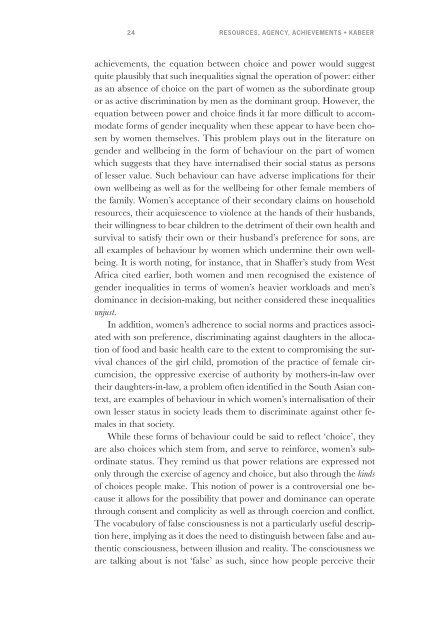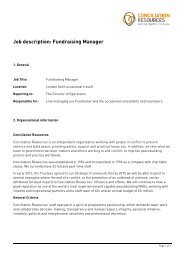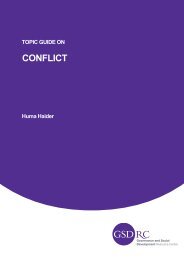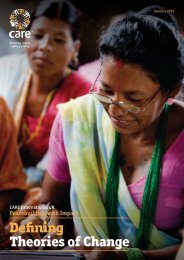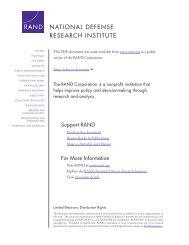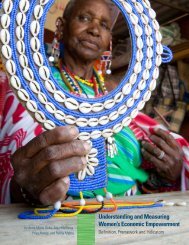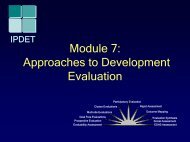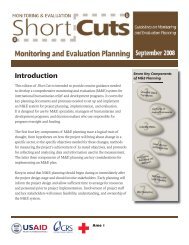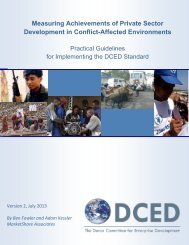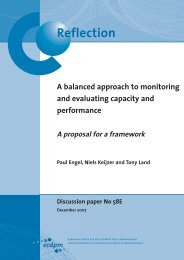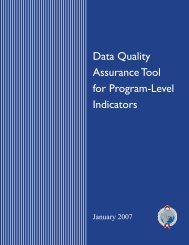Discussing Women's Empowerment - Sida
Discussing Women's Empowerment - Sida
Discussing Women's Empowerment - Sida
You also want an ePaper? Increase the reach of your titles
YUMPU automatically turns print PDFs into web optimized ePapers that Google loves.
24 RESOURCES, AGENCY, ACHIEVEMENTS • KABEER<br />
achievements, the equation between choice and power would suggest<br />
quite plausibly that such inequalities signal the operation of power: either<br />
as an absence of choice on the part of women as the subordinate group<br />
or as active discrimination by men as the dominant group. However, the<br />
equation between power and choice finds it far more difficult to accommodate<br />
forms of gender inequality when these appear to have been chosen<br />
by women themselves. This problem plays out in the literature on<br />
gender and wellbeing in the form of behaviour on the part of women<br />
which suggests that they have internalised their social status as persons<br />
of lesser value. Such behaviour can have adverse implications for their<br />
own wellbeing as well as for the wellbeing for other female members of<br />
the family. Women’s acceptance of their secondary claims on household<br />
resources, their acquiescence to violence at the hands of their husbands,<br />
their willingness to bear children to the detriment of their own health and<br />
survival to satisfy their own or their husband’s preference for sons, are<br />
all examples of behaviour by women which undermine their own wellbeing.<br />
It is worth noting, for instance, that in Shaffer’s study from West<br />
Africa cited earlier, both women and men recognised the existence of<br />
gender inequalities in terms of women’s heavier workloads and men’s<br />
dominance in decision-making, but neither considered these inequalities<br />
unjust.<br />
In addition, women’s adherence to social norms and practices associated<br />
with son preference, discriminating against daughters in the allocation<br />
of food and basic health care to the extent to compromising the survival<br />
chances of the girl child, promotion of the practice of female circumcision,<br />
the oppressive exercise of authority by mothers-in-law over<br />
their daughters-in-law, a problem often identified in the South Asian context,<br />
are examples of behaviour in which women’s internalisation of their<br />
own lesser status in society leads them to discriminate against other females<br />
in that society.<br />
While these forms of behaviour could be said to reflect ‘choice’, they<br />
are also choices which stem from, and serve to reinforce, women’s subordinate<br />
status. They remind us that power relations are expressed not<br />
only through the exercise of agency and choice, but also through the kinds<br />
of choices people make. This notion of power is a controversial one because<br />
it allows for the possibility that power and dominance can operate<br />
through consent and complicity as well as through coercion and conflict.<br />
The vocabulory of false consciousness is not a particularly useful description<br />
here, implying as it does the need to distinguish between false and authentic<br />
consciousness, between illusion and reality. The consciousness we<br />
are talking about is not ‘false’ as such, since how people perceive their


